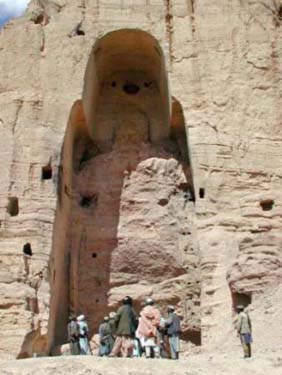TOKYO - Forget Renaissance Europe. The world's first oil paintings go back nearly 14 centuries to murals in Afghanistan's Bamiyan caves, a Japanese researcher says.

The tallest Buddha figure in the world, 55m;180 ft; created in the 3rd century A.D.

The tallest Buddha after it was destroyed by ignorant Taliban in March 2001
Buddhist images painted in the central Afghan region, dated to around 650 AD, are the earliest examples of oil used in art history, says Yoko Taniguchi, an expert at Japan's National Research Institute for Cultural Properties.
A group of Japanese, European and US scientists are collaborating to restore damaged murals in caves in the Bamiyan Valley, famous for its two gigantic statues of the Buddha which were destroyed by the Taliban in 2001.
In the murals, thousands of Buddhas in vermilion robes sit cross-legged, sporting exquisitely knotted hair.
Other motifs show crouching monkeys, men facing one another or palm leaves delicately intertwined with mythical creatures.
The paintings incorporate a mix of Indian and Chinese influences, and are most likely to be the works of artists traveling on the Silk Road, which was the largest trade and cultural route connecting the East and the West.
The Los Angeles-based Getty Conservation Institute analysed 53 samples extracted from the murals. Using gas chromatography methods, the researchers found that 19 had oil in the paint.
"Different types of oil were used on the dirt walls with such a sophisticated technique that I felt I was looking right at a medieval board painting dating from 14th or 15th century Italy," Taniguchi told AFP.
The discovery would reverse common perceptions about the origins of oil paintings.
The technique is widely believed to have emerged in Europe leading into the Renaissance, which flowered from 1400 to 1600.
Italian artist and architect Giorgio Vasari first wrote of oil painting in his book, "The Lives of the Artists," in the mid-16th century.
Art historians, however, argue that 15th-century Flemish painter Jan van Eyck may have known of the technique because he had developed a stable varnish, although he kept it secret until his death.
"It was very impressive to discover that such advanced methods were used in murals in central Asia," Taniguchi said.
"My European colleagues were shocked because they always believed oil paintings were invented in Europe. They couldn't believe such techniques could exist in some Buddhist cave deep in the countryside," she added.
Painters of the Buddhist murals used organic substances -- including natural resin, plant gum, dry oil and animal protein -- as a binder, which even today is an important element in paint.
A binder keeps pigment particles together in a cohesive film and allows the paint to resist decay.
The researchers are trying to restore the murals amid international efforts to salvage what is left of Bamiyan.
The Taliban, ignoring global protests, dynamited the two 1,500-year-old statues, the world's biggest representations of the Buddha, in March 2001, branding them un-Islamic idolatry.
The regime was ousted later that year in a US-led military campaign after the September 11 attacks on the United States.
Although oil was used in ancient Egypt, Greece and Rome, there currently exist no examples of their use in painting. The oil was used for medicine, cosmetics or to coat boats, Taniguchi said.
Taniguchi hopes the advanced techniques used to analyse the murals would be put to use in ruins of other ancient civilisations.
Other early civilisations including those in current-day Iran, China, Turkey, Pakistan and India may have used similar techniques as well but their ruins have not been subject to advanced, extensive research, she said.
"In analysing old murals throughout Europe and Central Asia, I look forward to throwing light on the roots of oil paintings," she said.



